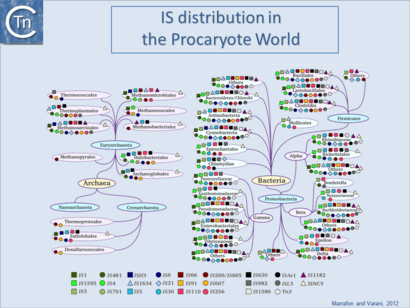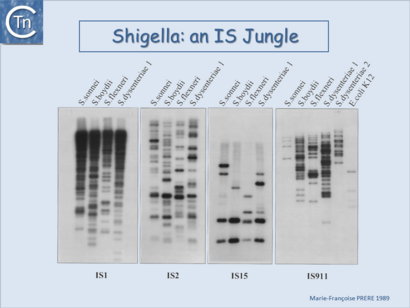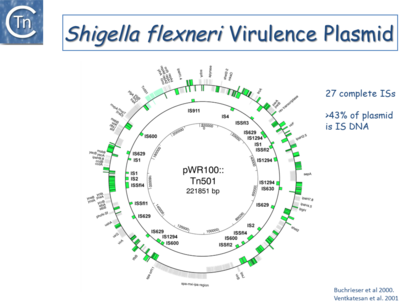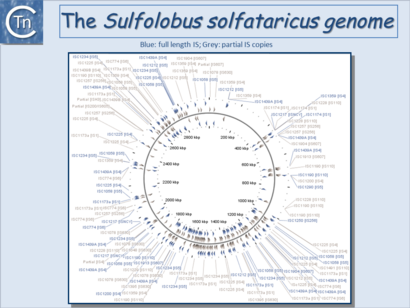Difference between revisions of "General Information/IS Distribution"
| Line 3: | Line 3: | ||
<center> | <center> | ||
{| | {| | ||
| − | ![[Image:1.6.1.png|thumb|center|410x410px| | + | ![[Image:1.6.1.png|thumb|center|410x410px|Fig.1.6.1. '''IS distribution in the prokaryotic world.''' |alt=|border]] |
| − | ![[Image:1.6.2.png|thumb|center|410x410px|Fig1.6.2 <i> | + | ![[Image:1.6.2.png|thumb|center|410x410px|Fig1.6.2. <i>Shigella</i>: and IS jungle |alt=|border]] |
|- | |- | ||
| − | |[[Image:1.6.3.png|thumb|center|410x410px| | + | |[[Image:1.6.3.png|thumb|center|410x410px|'''Fig.1.6.3.''' The <i>Shiguella flexneri</i> virulence plasmid circular map. |alt=|border]] |
| − | |[[Image:1.6.4.png|thumb|center|410x410px| | + | |[[Image:1.6.4.png|thumb|center|410x410px|'''Fig.1.6.4.''' The <i>Sulfolobus solfataricus</i> circular genome representation showing only IS (complete and partials) |alt=]] |
|} | |} | ||
</center> | </center> | ||
==Bibliography== | ==Bibliography== | ||
<references /> | <references /> | ||
Revision as of 13:46, 30 April 2020
ISs are widespread (Fig.1.6.1) and can occur in very high numbers in prokaryotic genomes. A recent study concluded that proteins annotated as Tpases, or as proteins with related functions are by far the most abundant functional class in both the prokaryotic and eukaryotic genomic and metagenomic public databases[1] (Fig.1.2.5). Since the last surveys (e.g. [2]) many new ISs have been identified largely as a result of the massive increase in available sequenced prokaryotic genomes. Careful analysis of a number of these has also revealed that some genomes contain significant levels of truncated and partial ISs devoid of Tpase genes. These genomic "scars" represent traces of numerous ancestral transposition events. However, genome annotations are often based simply on the presence of Tpase genes (e.g. [3]) and do not include the entire DNA sequence with the IS ends. Indeed, a significant number of solo IS-related IRs have been identified in various genomes. Small IS fragments are rarely taken into account even though they can provide important insights into the evolutionary history of the host genome (Fig.1.6.2), (Fig.1.6.3) and (Fig.1.6.4). Not only can this seriously impair studies attempting to provide an overview of the evolutionary influence of TEs on bacterial and archeal genomes, but such fragments may encode truncated proteins and these could influence gene regulation (e.g. [4][5][6]). In bacteria [7][8][9][10] and eukaryotes[11][12] truncated transposases have been shown to inhibit transposition. One example where annotation of IS fragments has provided important information is in the obligatory intracellular insect endosymbiont, Wolbachia, which also carries high numbers of full-length ISs. The sequence divergence observed suggests that several waves of IS invasion and elimination have occurred over evolutionary time[13].
Bibliography
- ↑ <pubmed>20215432</pubmed>
- ↑ <pubmed>9729608</pubmed>
- ↑ <pubmed>17251179</pubmed>
- ↑ <pubmed>16672366</pubmed>
- ↑ <pubmed>20309721</pubmed>
- ↑ <pubmed>19390626</pubmed>
- ↑ <pubmed>2154486</pubmed>
- ↑ <pubmed>11705917</pubmed>
- ↑ <pubmed>17078817</pubmed>
- ↑ <pubmed>8226636</pubmed>
- ↑ <pubmed>1662417</pubmed>
- ↑ <pubmed>8391505</pubmed>
- ↑ <pubmed>21940637</pubmed>



